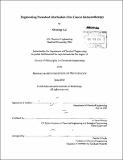| dc.contributor.advisor | K. Dane Wittrup. | en_US |
| dc.contributor.author | Gai, Shuning | en_US |
| dc.contributor.other | Massachusetts Institute of Technology. Dept. of Chemical Engineering. | en_US |
| dc.date.accessioned | 2013-02-14T15:32:06Z | |
| dc.date.available | 2013-02-14T15:32:06Z | |
| dc.date.copyright | 2012 | en_US |
| dc.date.issued | 2012 | en_US |
| dc.identifier.uri | http://hdl.handle.net/1721.1/76957 | |
| dc.description | Thesis (Ph. D.)--Massachusetts Institute of Technology, Dept. of Chemical Engineering, 2012. | en_US |
| dc.description | Cataloged from PDF version of thesis. | en_US |
| dc.description | Includes bibliographical references (p. 102-109). | en_US |
| dc.description.abstract | Mobilizing the immune system to recognize and destroy tumor cells is a promising strategy for treating cancer. In contrast to standard therapeutic approaches such as surgery, radiation, and chemotherapy, immunotherapy offers the possibility of systemic yet tumor-specific cell killing as well as long-lasting cancer protection. A significant mode of tumor rejection is direct tumor cell killing by immune cells, such as cytotoxic T lymphocytes (CTLs) and natural killer (NK) cells. These cell types are stimulated to proliferate by the cytokine interleukin-2 (IL-2). Consequently, IL-2 has been actively pursued as an agent for immunotherapy, either alone or in combination with other therapeutic strategies. IL-2 is characterized by rapid systemic clearance, with a fast-phase serum half-life of 13 minutes and a slow-phase half-life of 85 minutes. We hypothesized that prolonging the persistence of IL-2 at the cell surface or extending its circulation lifetime would increase its immunostimulatory potency. Therefore, we evolved murine IL-2 to bind the alpha subunit of its receptor, known as IL-2Ra or CD25, with 500-fold higher affinity; tethered IL-2 to the surface of T cells via streptavidin sandwiches; and fused IL-2 to the antibody Fc fragment, designated Fc/ IL-2, which extended the slow-phase serum half-life by 15 hours. Compared to free IL-2, Fc/IL-2 fusions induced superior control of solid tumors in mice. Interestingly, combining Fc/IL-2 with an anti-tumor antibody led to potent suppression of tumor growth during treatment. Furthermore, combination therapy protected two of three mice from subsequent tumor re-challenge. Depletion of CTLs or NK cells completely or partially, respectively, abrogated treatment efficacy, suggesting these immune cell types contribute to the anti-tumor response. In the context of Fc fusion, increasing the affinity of IL-2 for CD25 did not further improve efficacy. Ablation of CD25 binding, however, significantly reduced efficacy and also increased treatment toxicity. Since we employed a mutant Fc with disrupted FcyR binding, and hence reduced effector function, and fused IL-2 to mutant Fc monovalently, the significant therapeutic benefit of Fc/IL-2 over free IL-2 likely results from the extension of IL-2 circulation lifetime. We hypothesize that long-circulating IL-2 would potently synergize with other anti-tumor antibodies for effective cancer immunotherapy. | en_US |
| dc.description.statementofresponsibility | by Shuning Gai. | en_US |
| dc.format.extent | 113 p. | en_US |
| dc.language.iso | eng | en_US |
| dc.publisher | Massachusetts Institute of Technology | en_US |
| dc.rights | M.I.T. theses are protected by
copyright. They may be viewed from this source for any purpose, but
reproduction or distribution in any format is prohibited without written
permission. See provided URL for inquiries about permission. | en_US |
| dc.rights.uri | http://dspace.mit.edu/handle/1721.1/7582 | en_US |
| dc.subject | Chemical Engineering. | en_US |
| dc.title | Engineering persistent interleukin-2 for cancer immunotherapy | en_US |
| dc.title.alternative | Engineering persistent interleukin-two for cancer immunotherapy | en_US |
| dc.title.alternative | Engineering persistent IL-2 for cancer immunotherapy | en_US |
| dc.type | Thesis | en_US |
| dc.description.degree | Ph.D. | en_US |
| dc.contributor.department | Massachusetts Institute of Technology. Department of Chemical Engineering | |
| dc.identifier.oclc | 824730262 | en_US |
